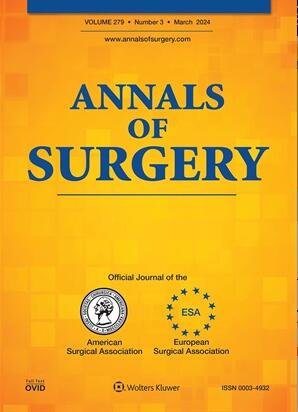Carbohydrate Antigen 19-9 Delta Function for Survival Prediction in Borderline Pancreatic Cancer. A PANC-PALS Consortium International Multicenter Derivation and Validation Study.
IF 7.5
1区 医学
Q1 SURGERY
引用次数: 0
Abstract
OBJECTIVE To establish a novel method for evaluating carbohydrate antigen 19-9 (CA19-9) during neoadjuvant therapy (NAT) and assess its role in predicting overall (OS) and disease-free (DFS) survival in borderline resectable pancreatic adenocarcinoma (BR-PC). SUMMARY BACKGROUND DATA Static CA19-9 values or percentage changes often fail to capture therapeutic responses in patients with BR-PC undergoing NAT. Improved evaluation methods are essential for guiding the treatment. METHODS This was a retrospective multicenter study of patients who underwent BR-PC surgery. Two parameters were developed: slope coefficient (SC, change in CA19-9 divided by therapy duration) and mean δf (mδf, calculated as the sum of CA19-9 values over therapy intervals divided by the number of 15-day periods). The main objective was to correlate mδf with OS thresholds derived using a maximally selected log-rank statistic and validated in independent cohorts. RESULTS Overall, 991 patients (median age 65 [59-71] years; 49% male) were included. The thresholds for mδf were defined as U.mL-1. month-1 (negative SC) and U.mL-1. month-1 (positive SC). Patients with mδf below these thresholds had significantly better prognoses, with hazard ratios (HR) for OS (95% CI) of 0.6 (0.4-0.8; P<0.01) and 0.4 (0.2-0.9; P=0.04) for negative and positive SC, respectively. Both thresholds were validated for mOS, with 29 vs 22 months (P=0.015) and 32 vs 16 months (P=0.0034) for negative and positive SC, respectively. Similarly, the mDFS was 13 vs 10 months (P=0.011) and 12 vs 7 months (P=0.0018), respectively. CONCLUSION This CA19-9 evaluation approach accurately predicts survival outcomes, offering a valuable tool for optimizing treatment strategies. An mδf calculator is available at https://www.pancpals.com/tools.碳水化合物抗原19-9 δ函数预测交界性胰腺癌的生存。PANC-PALS联盟国际多中心衍生和验证研究。
目的建立一种新辅助治疗(NAT)中碳水化合物抗原19-9 (CA19-9)的评估方法,并评估其在预测边缘性可切除胰腺腺癌(BR-PC)总生存期(OS)和无病生存期(DFS)中的作用。数据统计的CA19-9值或百分比变化往往不能反映BR-PC患者行NAT的治疗反应。改进的评估方法对于指导治疗至关重要。方法对BR-PC手术患者进行回顾性多中心研究。开发了两个参数:斜率系数(SC, CA19-9的变化除以治疗时间)和平均δf (mδf,计算方法为CA19-9值在治疗间隔内的总和除以15天的疗程数)。主要目的是将mδf与OS阈值关联起来,该阈值使用最大选择的对数秩统计量得出,并在独立队列中进行验证。结果991例患者(中位年龄65[59-71]岁;(49%为男性)。mδf的阈值定义为uml -1。第1个月(阴性SC)和U.mL-1。第1个月(SC阳性)。mδf低于这些阈值的患者预后明显更好,OS的风险比(HR) (95% CI)为0.6 (0.4-0.8;P<0.01)和0.4 (0.2 ~ 0.9;P=0.04)。这两个阈值都对mOS进行了验证,阴性和阳性SC分别为29个月和22个月(P=0.015)和32个月和16个月(P=0.0034)。同样,mDFS分别为13个月vs 10个月(P=0.011)和12个月vs 7个月(P=0.0018)。结论该CA19-9评价方法可准确预测生存结果,为优化治疗策略提供了有价值的工具。一个mδf计算器可以在https://www.pancpals.com/tools上找到。
本文章由计算机程序翻译,如有差异,请以英文原文为准。
求助全文
约1分钟内获得全文
求助全文
来源期刊

Annals of surgery
医学-外科
CiteScore
14.40
自引率
4.40%
发文量
687
审稿时长
4 months
期刊介绍:
The Annals of Surgery is a renowned surgery journal, recognized globally for its extensive scholarly references. It serves as a valuable resource for the international medical community by disseminating knowledge regarding important developments in surgical science and practice. Surgeons regularly turn to the Annals of Surgery to stay updated on innovative practices and techniques. The journal also offers special editorial features such as "Advances in Surgical Technique," offering timely coverage of ongoing clinical issues. Additionally, the journal publishes monthly review articles that address the latest concerns in surgical practice.
 求助内容:
求助内容: 应助结果提醒方式:
应助结果提醒方式:


